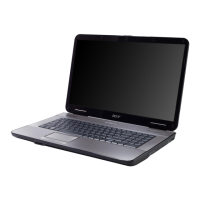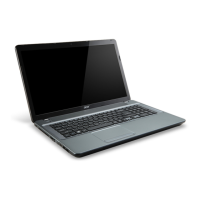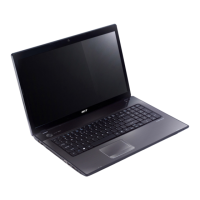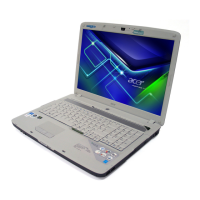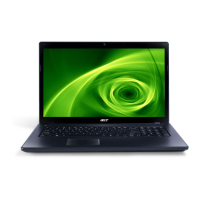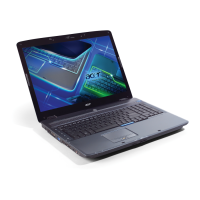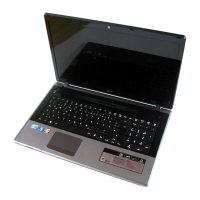
Do you have a question about the Acer Aspire 7715 Series and is the answer not in the manual?
| Optical Drive | DVD-Super Multi double-layer drive |
|---|---|
| CPU | Intel Core 2 Duo |
| Memory | Up to 4 GB DDR2 |
| Storage | 160GB SATA HDD |
| Wireless | 802.11b/g Wi-Fi |
| LAN | Gigabit Ethernet |
| Webcam | Acer Crystal Eye webcam |
| Operating System | Windows Vista |
| Screen Size | 17 inches |
Provides a brief summary of the computer’s many features, noting model-specific items.
Illustrates the internal architecture and component connections of the system.
Details key hardware components like processor, BIOS, memory, and storage.
Identifies components and indicators visible on the front of the notebook.
Identifies ports and connectors located on the left side of the notebook.
Identifies ports and features located on the right side of the notebook.
Identifies the battery bay, release latch, and other bottom-mounted components.
Explains the meaning of various status indicator lights on the computer.
Explains how to use the touchpad and its various functions.
Details the functionality of Caps Lock, Num Lock, and the embedded numeric keypad.
Describes the function of Windows-specific keys and common shortcuts.
Explains the use of function key combinations for system controls like brightness and volume.
Explains the purpose and access method for the BIOS setup utility.
Provides instructions on navigating BIOS menus and parameter options.
Displays system hardware information summarized within the BIOS.
Allows setting system time/date and configuring boot options.
Configures advanced BIOS options for system performance and features.
Manages BIOS passwords for system protection and unauthorized access.
Configures BIOS power management and CPU control settings.
Sets the order of boot devices for loading the operating system.
Saves or discards BIOS changes and exits the utility.
Details the procedure for updating the system BIOS using a DOS utility.
Explains how to use the Windows-based utility for BIOS updates.
Provides step-by-step instructions to reset the HDD password.
Details methods for clearing BIOS passwords via jumper or utility.
Allows changing boot order without entering BIOS setup.
Explains updating DMI pool information for hardware management.
Details writing MAC values to EEPROM using a DOS utility.
Lists necessary tools and important notes for disassembling the computer.
Provides essential safety and preparatory steps before disassembly.
Illustrates the sequence for removing external computer components.
Step-by-step guide on how to safely remove the laptop's battery.
Guide for removing the memory and HDD covers on the laptop base.
Steps to remove the optical drive from its bay.
Instructions for removing the system's RAM modules.
Guide on how to remove the wireless LAN card.
Steps to remove the hard disk drive from its bay.
Outlines the process for disassembling the main internal components.
Instructions for removing the switch cover assembly.
Step-by-step guide on how to remove the laptop keyboard.
Instructions for removing the entire LCD module assembly.
Guide for removing the top case assembly.
Steps to remove the laptop's power board.
Instructions for removing the left speaker assembly.
Instructions for removing the right speaker assembly.
Guide on how to remove the touchpad bracket.
Steps to remove the system's main circuit board.
Instructions for removing the Real-Time Clock battery.
Guide to removing the CPU heatsink and fan assembly.
Steps to remove the fan that cools the CPU.
Instructions for safely removing the Central Processing Unit.
Diagram showing the sequence for disassembling the LCD module.
Steps to remove the front bezel of the LCD screen.
Instructions for removing the integrated camera.
Guide on how to remove the actual LCD screen panel.
Steps to reinstall the Central Processing Unit into its socket.
Instructions for reinstalling the CPU cooling fan.
Guide to reinstalling the CPU heatsink assembly.
Steps to reinstall the system's main circuit board.
Guide on how to reinstall the touchpad bracket.
Instructions for reinstalling the right speaker assembly.
Instructions for reinstalling the left speaker assembly.
Steps to reinstall the laptop's power board.
Guide for reinstalling the top case assembly.
Steps to reinstall the entire LCD module assembly.
Step-by-step guide on how to reinstall the laptop keyboard.
Instructions for reinstalling the switch cover assembly.
Steps to reinstall the hard disk drive into its bay.
Guide on how to reinstall the wireless LAN card.
Instructions for reinstalling the system's RAM modules.
Steps to reinstall the optical drive.
Guide for reinstalling the memory and HDD covers on the laptop base.
Instructions for reinstalling the SD dummy card.
Step-by-step guide on how to safely reinstall the laptop's battery.
Guide to diagnosing and resolving common computer issues.
Troubleshooting steps for when the system does not power on.
Troubleshooting steps for scenarios with no video output.
Troubleshooting steps for unusual or distorted video output.
Steps to resolve intermittent loss of BIOS settings.
Troubleshooting steps for LCD screen malfunctions.
Steps to resolve issues with the built-in keyboard.
Troubleshooting steps for touchpad malfunctions.
Steps to resolve issues with the internal speakers.
Troubleshooting steps for audio output issues.
Steps to resolve internal or external microphone issues.
Troubleshooting steps for hard disk drive malfunctions.
Troubleshooting steps for optical drive failures.
Steps to resolve wireless LAN connectivity issues.
Troubleshooting steps for thermal unit issues.
Steps to resolve external mouse issues.
Troubleshooting for various other component failures.
Steps to diagnose and resolve intermittent system hangs.
Procedure to isolate failing FRUs when the cause is unclear.
POST codes related to security and setup operations.
POST codes related to memory initialization and checks.
Illustrates exploded views of major assemblies for parts identification.
Exploded diagram of the main laptop components.
Exploded diagram of the base components like CPU and thermal module.
Exploded diagram of rear components like HDD and RAM covers.
Comprehensive list of all Field Replaceable Units with part numbers.
Lists available power cords and TP FFC.
Lists chassis parts such as upper/lower cases and brackets.
Catalog of screws used in various disassembly and reassembly steps.
Procedure to clear BIOS passwords by shorting a jumper.
Identifies the jumper used for clearing CMOS settings.
Detailed steps for BIOS recovery using USB storage.
Defines configurations and specifications for Aspire 7315 models.
Defines configurations and specifications for Aspire 7715Z models.
Lists components tested and verified under Windows 7 environment.
